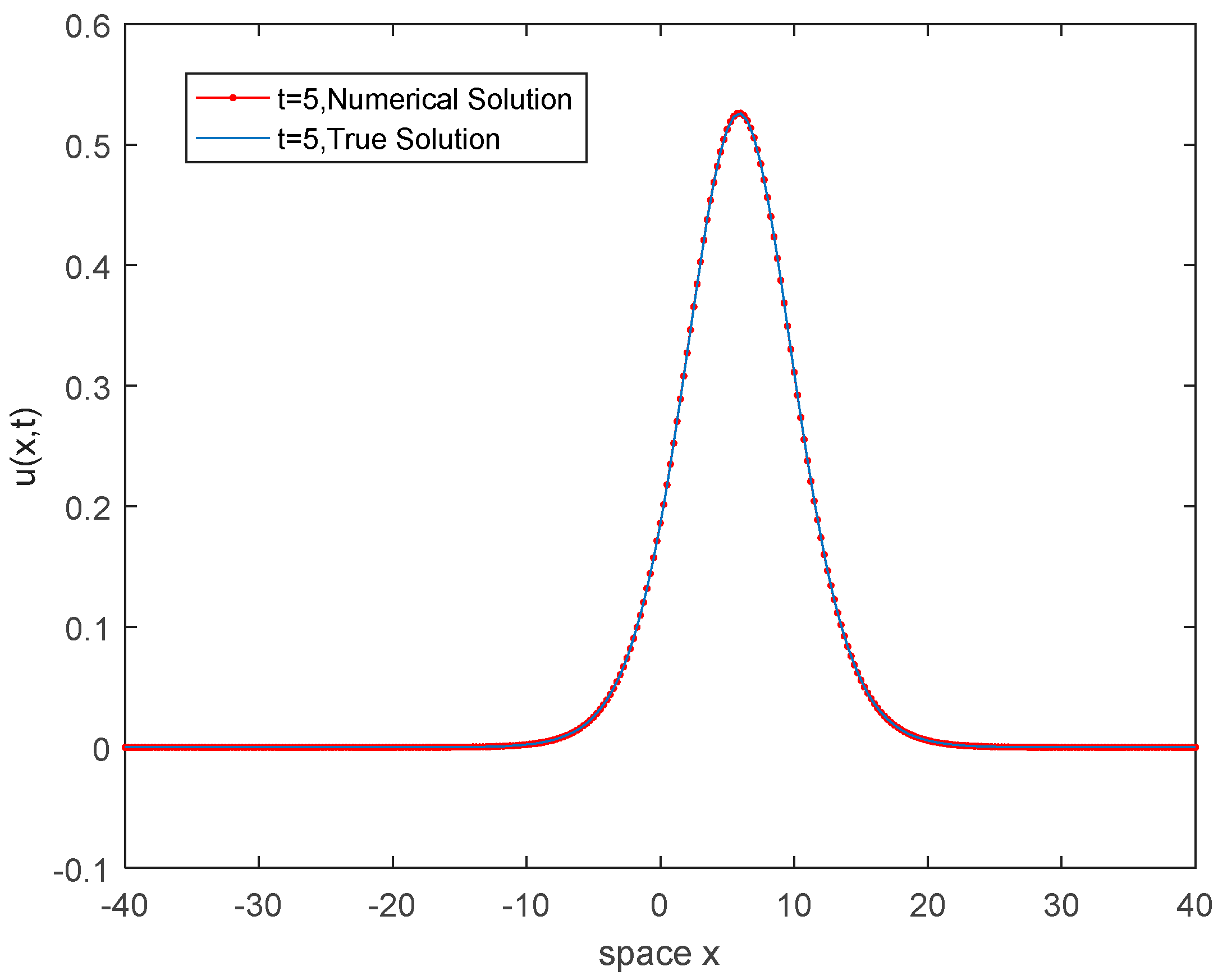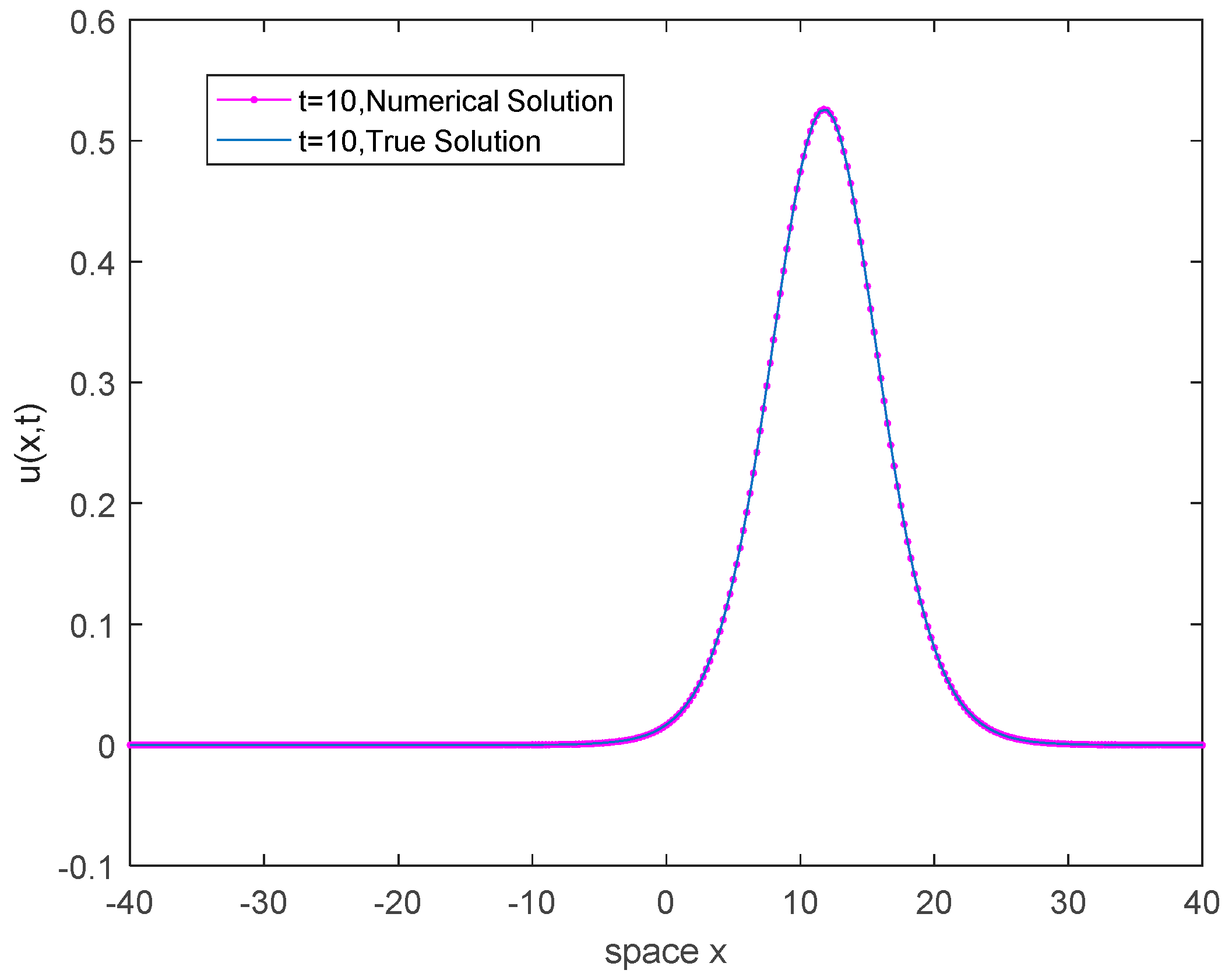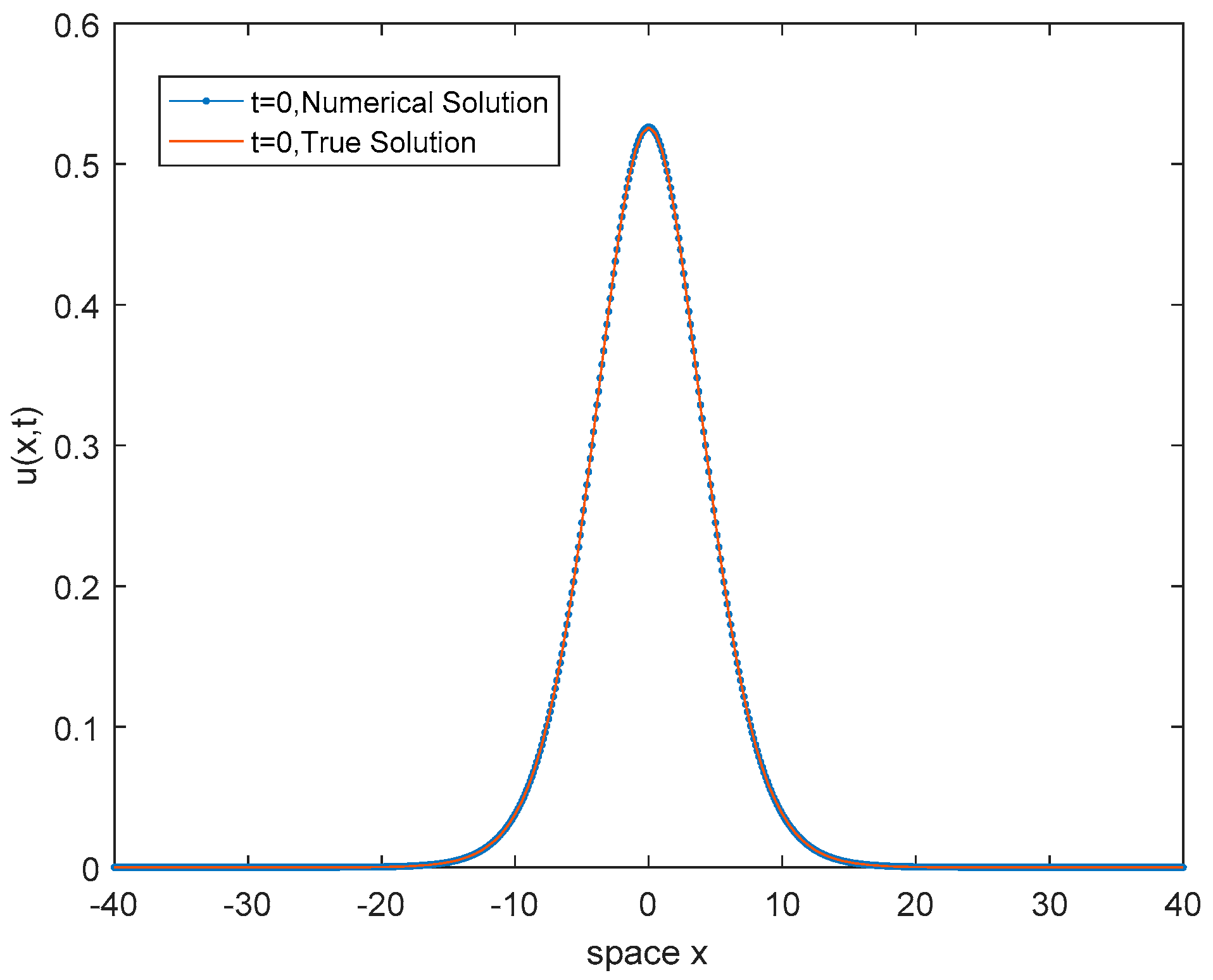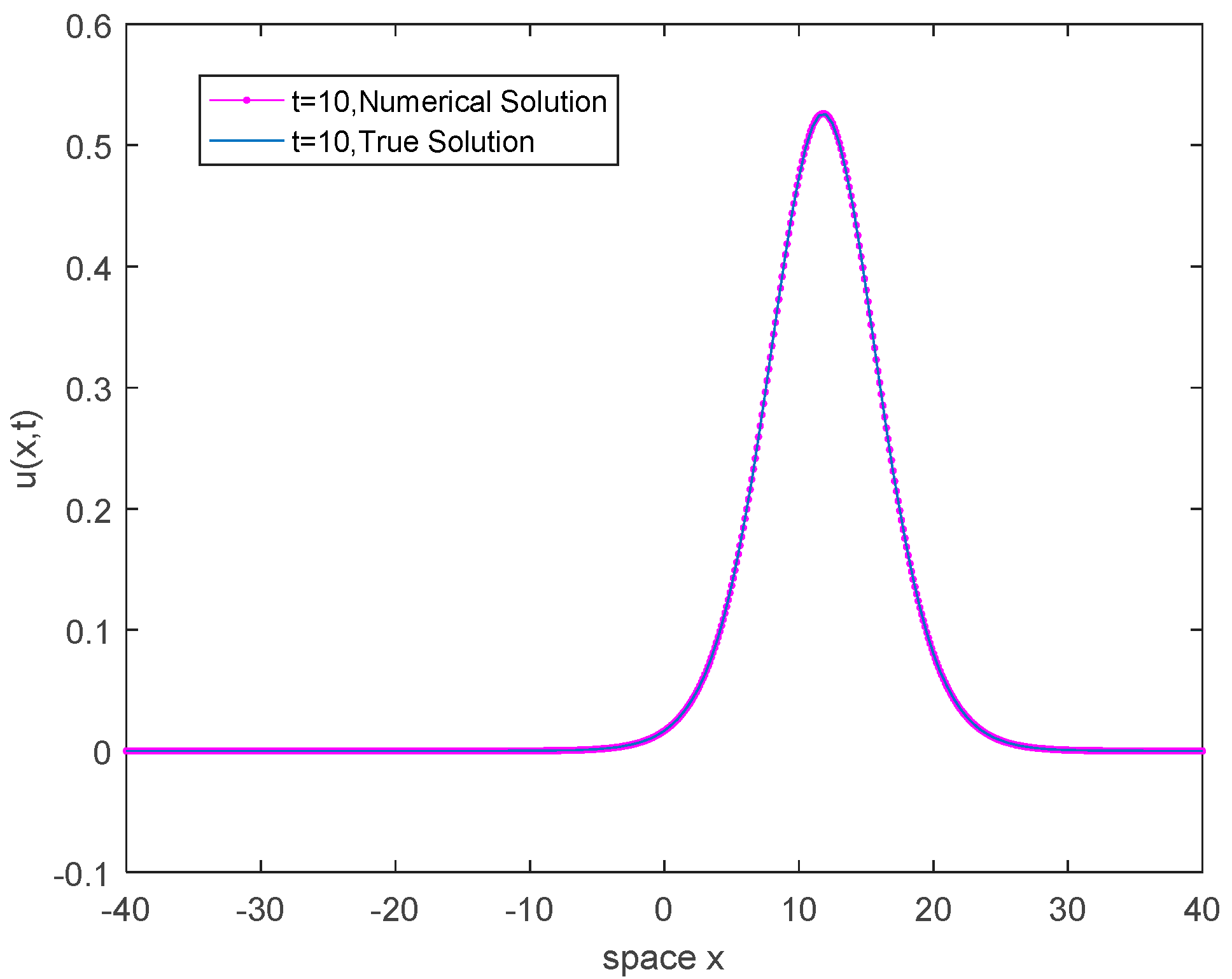A Conservative and Implicit Second-Order Nonlinear Numerical Scheme for the Rosenau-KdV Equation
Abstract
1. Introduction
2. A Two-Level Implicit Nonlinear Discrete Scheme and Its Conservative Law
2.1. Notation
2.2. The Multiple Integral Finite Volume Method(MIFVM)
2.3. A Two-Level Implicit Nonlinear Discrete Scheme
2.4. Conservative Law of the Discrete Scheme
3. Solvability
4. Some Prior Estimates for the Discrete Scheme
5. Convergence and Stability of the Discrete Scheme
6. Uniqueness of the Numerical Solution
7. Results
7.1. Example
7.2. Figures, Tables, and Schemes
8. Conclusions
Author Contributions
Funding
Institutional Review Board Statement
Informed Consent Statement
Data Availability Statement
Acknowledgments
Conflicts of Interest
References
- Yokus, A.; Bulut, H. Numerical simulation of KdV equation by finite difference method. Indian J. Phys. 2018, 92, 1571–1575. [Google Scholar] [CrossRef]
- Başhan, A. A novel approach via mixed Crank–Nicolson scheme and differential quadrature method for numerical solutions of solitons of mKdV equation. Pramana-J. Phys. 2019, 92, 84. [Google Scholar] [CrossRef]
- Başhan, A.; Yağmurlu, N.M.; Uçar, Y.; Esen, A. A new perspective for the numerical solutions of the cmKdV equation via modified cubic B-spline differential quadrature method. Int. J. Mod. Phys. C 2018, 29, 1850043. [Google Scholar] [CrossRef]
- Kong, D.; Xu, Y.; Zheng, Z. Numerical method for generalized time fractional KdV-type equation. Numer. Methods Partial. Differ. Equ. 2019, 36, 906–936. [Google Scholar] [CrossRef]
- Cairone, F.; Anandan, P.; Bucolo, M. Nonlinear systems synchronization for modeling two-phase microfluidics flows. Nonlinear Dyn. 2017, 92, 75–84. [Google Scholar] [CrossRef]
- Wazwaz, A.-M. A new integrable equation that combines the KdV equation with the negative-order KdV equation. Math. Methods Appl. Sci. 2018, 41, 80–87. [Google Scholar] [CrossRef]
- Wazwaz, A.-M. Negative-order KdV equations in (3 + 1) dimensions by using the KdV recursion operator. Waves Random Complex Media 2017, 27, 768–778. [Google Scholar] [CrossRef]
- Rosenau, P. A Quasi-Continuous Description of a Nonlinear Transmission Line. Phys. Scr. 1986, 34, 827–829. [Google Scholar] [CrossRef]
- Rosenau, P. Dynamics of Dense Discrete Systems: High Order Effects. Prog. Theor. Phys. 1988, 79, 1028–1042. [Google Scholar] [CrossRef]
- Park, M.A. On the Rosenau equation. Matemática Aplic. Comput. 1990, 9, 145–152. [Google Scholar]
- Erbay, H.; Erbay, S.; Erkip, A. Numerical computation of solitary wave solutions of the Rosenau equation. Wave Motion 2020, 98, 102618. [Google Scholar] [CrossRef]
- Atouani, N.; Ouali, Y.; Omrani, K. Mixed finite element methods for the Rosenau equation. J. Appl. Math. Comput. 2018, 57, 393–420. [Google Scholar] [CrossRef]
- Michihisa, H. New asymptotic estimates of solutions for generalized Rosenau equations. Math. Methods Appl. Sci. 2019, 42, 4516–4542. [Google Scholar] [CrossRef]
- Shi, D.; Jia, X. Superconvergence analysis of the mixed finite element method for the Rosenau equation. J. Math. Anal. Appl. 2020, 481, 123485. [Google Scholar] [CrossRef]
- Safdari-Vaighani, A.; Larsson, E.; Heryudono, A. Radial Basis Function Methods for the Rosenau Equation and Other Higher Order PDEs. J. Sci. Comput. 2018, 75, 1555–1580. [Google Scholar] [CrossRef]
- Wang, Y.; Feng, G. Large-time behavior of solutions to the Rosenau equation with damped term. Math. Methods Appl. Sci. 2017, 40, 1986–2004. [Google Scholar] [CrossRef]
- Wang, X.; Dai, W. A conservative fourth-order stable finite difference scheme for the generalized Rosenau–KdV equation in both 1D and 2D. J. Comput. Appl. Math. 2019, 355, 310–331. [Google Scholar] [CrossRef]
- Luo, Y.; Xu, Y.; Feng, M. Conservative Difference Scheme for Generalized Rosenau-KdV Equation. Adv. Math. Phys. 2014, 2014, 986098. [Google Scholar] [CrossRef]
- Hussain, M.; Haq, S. Numerical simulation of solitary waves of Rosenau–KdV equation by Crank–Nicolson meshless spectral interpolation method. Eur. Phys. J. Plus 2020, 135, 98. [Google Scholar] [CrossRef]
- Kutluay, S.; Karta, M.; Yağmurlu, N.M. Operator time-splitting techniques combined with quintic B-spline collocation method for the generalized Rosenau–KdV equation. Numer. Methods Partial. Differ. Equ. 2019, 35, 2221–2235. [Google Scholar] [CrossRef]
- Browder, F.E. Existence and uniqueness theorems for solutions of nonlinear boundary value problems. In Proceedings of the Sum of Squares: Theory and Applications; American Mathematical Society: Providence, RI, USA, 1965; Volume 17, pp. 24–49. [Google Scholar]
- Zhou, Y.L. Applications of Discrete Functional Analysis to the Finite Difference Method, 1st ed.; International Academic Publishers: Beijing, China, 1991; pp. 3–20. [Google Scholar]






| — | 2.81334134 | 2.82459484 | — | 3.98408169 | 3.99595175 | |
| — | 2.81287147 | 2.82383379 | — | 3.96857153 | 3.99439224 | |
| — | 2.81210118 | 2.81910310 | — | 3.98033046 | 3.98977197 | |
| — | 2.81112183 | 2.80206476 | — | 3.96316463 | 3.97306867 | |
| — | 2.81001148 | 2.75818454 | — | 3.97437701 | 3.93282902 | |
| 3.08675012 | 6.17349199 | 12.34697937 | |
| 3.08676651 | 6.17350095 | 12.34698364 | |
| 3.08679087 | 6.17351432 | 12.34698593 | |
| 3.08681918 | 6.17352996 | 12.34696462 | |
| 3.08684844 | 6.17354622 | 12.34685552 |
Publisher’s Note: MDPI stays neutral with regard to jurisdictional claims in published maps and institutional affiliations. |
© 2021 by the authors. Licensee MDPI, Basel, Switzerland. This article is an open access article distributed under the terms and conditions of the Creative Commons Attribution (CC BY) license (https://creativecommons.org/licenses/by/4.0/).
Share and Cite
Guo, C.; Wang, Y.; Luo, Y. A Conservative and Implicit Second-Order Nonlinear Numerical Scheme for the Rosenau-KdV Equation. Mathematics 2021, 9, 1183. https://doi.org/10.3390/math9111183
Guo C, Wang Y, Luo Y. A Conservative and Implicit Second-Order Nonlinear Numerical Scheme for the Rosenau-KdV Equation. Mathematics. 2021; 9(11):1183. https://doi.org/10.3390/math9111183
Chicago/Turabian StyleGuo, Cui, Yinglin Wang, and Yuesheng Luo. 2021. "A Conservative and Implicit Second-Order Nonlinear Numerical Scheme for the Rosenau-KdV Equation" Mathematics 9, no. 11: 1183. https://doi.org/10.3390/math9111183
APA StyleGuo, C., Wang, Y., & Luo, Y. (2021). A Conservative and Implicit Second-Order Nonlinear Numerical Scheme for the Rosenau-KdV Equation. Mathematics, 9(11), 1183. https://doi.org/10.3390/math9111183





